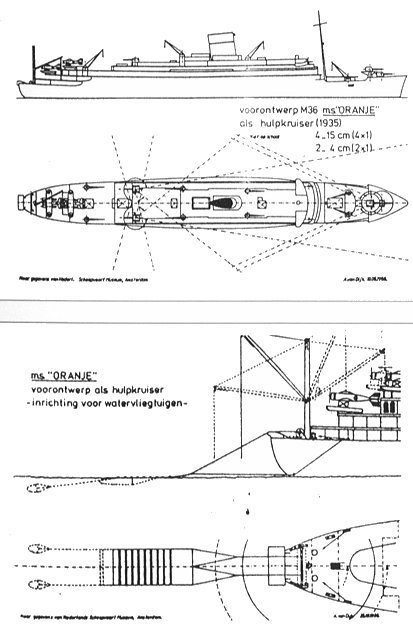Armed merchant cruisers are basically merchants, armed with a few cruiser-sized guns to augment the potential of a navy. The Royal Navy, tasked with the protection of vast amounts of ocean against raiders especially used this type of warship. Although the Dutch navy had far less ground to cover, the size of the NEI was simply too great to be able to effectively patrol it with the cruisers and destroyers. In addition, ships would have to be withdrawn to protect convoys. Not surprising, the use of AMCs was planned.
Armed Merchant Cruisers don't have any protection against shells, and they must therefore compensate this shortcoming with size and speed. On occasion, buoyancy was increased by stowing empty barrels in the cargoholds. Normally, old and large liners were chosen for conversion, armed with a few old guns. They were especially vulnerable to submarine- and airattacks. Their size and the lack of manoeuvrability made them easy prey for any passing submarine and aircraft. The following ships, all new and relatively fast, were chosen for conversion:
Nieuw Amsterdam was a new passengership, completed in 1938 with a size of 36.287 gross tons. Built for the Holland-Amerika-Lijn, she was to boast an armament of 4 x 150 mm guns, while she had an average maximum speed of 21 knots. During the war, she had a productive career as troopship.
 Oranje was the second largest ship in the list. Completed in 1939 for the Stoomvaart Maatschappij "Nederland", she measured 20.017 gross tons and had a speed of about 21 knots. She would have carried 4 double 120 mm guns and two 40 mm AA, while drawings also show two floatplanes on the stern. In 1940, conversion to AMC was considered in the Netherlands East Indies, but the lack of guns and personnel eventually pressed her into a role as hospitalship. Oranje was the second largest ship in the list. Completed in 1939 for the Stoomvaart Maatschappij "Nederland", she measured 20.017 gross tons and had a speed of about 21 knots. She would have carried 4 double 120 mm guns and two 40 mm AA, while drawings also show two floatplanes on the stern. In 1940, conversion to AMC was considered in the Netherlands East Indies, but the lack of guns and personnel eventually pressed her into a role as hospitalship.
Tegelberg was a 14.150 gross tons passengership completed in 1938 for the Koninklijke Paketvaart Maatschappij in Amsterdam. She would have boasted an armament of 3 double 120mm guns, while her speed averaged around 17 knots. In late 1940, conversion was considered by the naval staff in London, but the plans were dropped for the same reasons as with Oranje. She had a succesful career as troopship.
Ruys was a sistership of Tegelberg, completed in 1938. Conversion with the same armament was considered in 1940, but the plans were dropped for the same reasons as with Oranje. She fought as troopship during the war. Speed was about 17 knots.
Noordam was a 10.725 gross tons passengership, completed in 1938 for the Holland Amerika Lijn. She would have carried two double 120mm-guns after conversion. She survived the war as troopship. Maximum speed was about 17 knots.
Zaandam was the 10.909 gross tons sistership of Noordam, completed in 1939. She was torpedoed and sunk by U-174 in November 1942 with heavy loss of life.
Sommelsdijk was a 9.227 gross tons freighter, completed in 1939. She belonged to the Holland-Amerika-Lijn, and she survived the war. Sommelsdijk would have boasted an armament of 2 double 120mm guns. Maximum speed was about 15,5 knots.
Sloterdijk was Sommelsdijk's sistership, also completed in 1939. She measured 9.230 gross tons, and she too survived the war.
Bantam was a 9.312 gross tons freighter, completed in 1939 for the Rotterdamsche Lloyd. She would have carried 2 double 120mm guns. Maximum speed was about 16 knots.
Japara was a sistership of Bantam, completed in 1939. The planned specifications were otherwise the same.
Abbekerk was a 7906 gross tons freighter, completed in 1939 for the Vereenigde Nederlandsche Scheepvaart Mij (VNS). Her planned armament were
2 double 120mm guns, while her official speed was 17 knots. The actual maximum speed probably approached 20 knots.
Klipfontein was a 10.544 gross tons passengership, completed in 1939 for the VNS. Her armament would have consisted of 2 double 120mm guns. Speed was about 17 knots.
Oranjefontein wa a 10.547 gross tons passengership, sistership of the Klipfontein with the same armament. She was still under construction in May 1940,
and she subsequently entered service with Kriegsmarine. She retroceded to Holland in 1945 and entered service with the VNS. Speed was about 17 knots.
Elandsfontein was a 10.550 gross tons passengership, sistership of the Klipfontein and Oranjefontein. Still under construction in May 1940. shewould not be completed until 1950. Speed was about 17 knots.
As things turned out, none of the above were converted to armed merchant cruisers, although thought has been given to this plan during the war. The ships were all relatively new and fast, making them suited for troop- and cargoships. In addition, there was a shortage of guns and personnel.
|
![]()
![]()
![]()
![]()